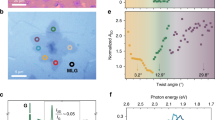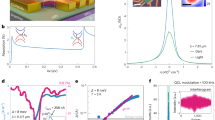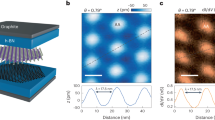Abstract
Small-twist-angle (<2°) bilayer graphene has received extraordinary attention recently due to its exciting physical properties1,2,3,4,5,6,7,8,9,10,11. Compared with monolayer graphene, the Brillouin zone folding in twisted bilayer graphene (TBG) leads to the formation of a superlattice bandgap and substantial modification to the density of states4,6,7,12,13. However, these emerging properties have rarely been leveraged to realize new optoelectronic devices. Here, we demonstrate the strong, gate-tunable photoresponse in the mid-infrared wavelength range of 5 to 12 μm. A maximum extrinsic photoresponsivity of 26 mA W−1 has been achieved at 12 μm when the Fermi level in 1.81° TBG was tuned to its superlattice bandgap. Moreover, the strong photoresponse critically depends on the formation of a superlattice bandgap, and it vanishes in the gapless case with an ultrasmall twist angle (<0.5°). Our demonstration reveals the promising optical properties of TBG and provides an alternative material platform for tunable mid-infrared optoelectronics.
This is a preview of subscription content, access via your institution
Access options
Access Nature and 54 other Nature Portfolio journals
Get Nature+, our best-value online-access subscription
$29.99 / 30 days
cancel any time
Subscribe to this journal
Receive 12 print issues and online access
$209.00 per year
only $17.42 per issue
Buy this article
- Purchase on Springer Link
- Instant access to full article PDF
Prices may be subject to local taxes which are calculated during checkout



Similar content being viewed by others
Data availability
The data that support the plots within this paper and other findings of this study are available from the corresponding authors on reasonable request.
References
Lopes dos Santos, J. M. B., Peres, N. M. R. & Castro Neto, A. H. Graphene bilayer with a twist: electronic structure. Phys. Rev. Lett. 99, 256802 (2007).
Mele, E. J. Commensuration and interlayer coherence in twisted bilayer graphene. Phys. Rev. B 81, 161405 (2010).
Bistritzer, R. & MacDonald, A. H. Moiré bands in twisted double-layer graphene. Proc. Natl Acad. Sci. USA 108, 12233–12237 (2011).
Cao, Y. et al. Superlattice-induced insulating states and valley-protected orbits in twisted bilayer graphene. Phys. Rev. Lett. 117, 116804 (2016).
Kim, K. et al. Tunable moiré bands and strong correlations in small-twist-angle bilayer graphene. Proc. Natl Acad. Sci. USA 114, 3364–3369 (2017).
Cao, Y. et al. Unconventional superconductivity in magic-angle graphene superlattices. Nature 556, 43–50 (2018).
Cao, Y. et al. Correlated insulator behaviour at half-filling in magic-angle graphene superlattices. Nature 556, 80–84 (2018).
Yankowitz, M. et al. Tuning superconductivity in twisted bilayer graphene. Science 363, 1059–1064 (2019).
Yoo, H. et al. Atomic and electronic reconstruction at the van der Waals interface in twisted bilayer graphene. Nat. Mater. 18, 448–453 (2019).
Sharpe, A. L. et al. Emergent ferromagnetism near three-quarters filling in twisted bilayer graphene. Science 365, 605–608 (2019).
Codecido, E. et al. Correlated insulating and superconducting states in twisted bilayer graphene below the magic angle. Sci. Adv. 5, eaaw9770 (2019).
Moon, P. & Koshino, M. Energy spectrum and quantum Hall effect in twisted bilayer graphene. Phys. Rev. B 85, 195458 (2012).
Trambly de Laissardière, G., Mayou, D. & Magaud, L. Numerical studies of confined states in rotated bilayers of graphene. Phys. Rev. B 86, 125413 (2012).
Ma, C. et al. Discovery of high dimensional band topology in twisted bilayer graphene. Preprint at https://arxiv.org/abs/1903.07950 (2019).
Wu, F., Lovorn, T., Tutuc, E., Martin, I. & MacDonald, A. H. Topological insulators in twisted transition metal dichalcogenide homobilayers. Phys. Rev. Lett. 122, 086402 (2019).
Wang, Y., Wang, Z., Yao, W., Liu, G.-B. & Yu, H. Interlayer coupling in commensurate and incommensurate bilayer structures of transition-metal dichalcogenides. Phys. Rev. B 95, 115429 (2017).
Lu, X. et al. Superconductors, orbital magnets and correlated states in magic-angle bilayer graphene. Nature 574, 653–657 (2019).
Xu, S. G. et al. Giant oscillations in a triangular network of one-dimensional states in marginally twisted graphene. Nat. Commun. 10, 4008 (2019).
Huang, S. et al. Topologically protected helical states in minimally twisted bilayer graphene. Phys. Rev. Lett. 121, 037702 (2018).
Tabert, C. J. & Nicol, E. J. Optical conductivity of twisted bilayer graphene. Phys. Rev. B 87, 121402 (2013).
Moon, P. & Koshino, M. Optical absorption in twisted bilayer graphene. Phys. Rev. B 87, 205404 (2013).
Le, H. A. & Do, V. N. Electronic structure and optical properties of twisted bilayer graphene calculated via time evolution of states in real space. Phys. Rev. B 97, 125136 (2018).
Li, G. et al. Observation of Van Hove singularities in twisted graphene layers. Nat. Phys. 6, 109–113 (2009).
Kim, C.-J. et al. Chiral atomically thin films. Nat. Nanotechnol. 11, 520–524 (2016).
Ponomarenko, L. A. et al. Cloning of Dirac fermions in graphene superlattices. Nature 497, 594–597 (2013).
Dean, C. R. et al. Hofstadter’s butterfly and the fractal quantum hall effect in moiré superlattices. Nature 497, 598–602 (2013).
Hunt, B. et al. Massive Dirac fermions and Hofstadter butterfly in a van der Waals heterostructure. Science 340, 1427–1430 (2013).
Patel, H. et al. Tunable optical excitations in twisted bilayer graphene form strongly bound excitons. Nano Lett. 15, 5932–5937 (2015).
Yin, J. et al. Selectively enhanced photocurrent generation in twisted bilayer graphene with van Hove singularity. Nat. Commun. 7, 10699 (2016).
Xin, W. et al. Photovoltage enhancement in twisted-bilayer graphene using surface plasmon resonance. Adv. Opt. Mater. 4, 1703–1710 (2016).
Yu, K. et al. Gate tunable optical absorption and band structure of twisted bilayer graphene. Phys. Rev. B 99, 241405 (2019).
Patel, H., Huang, L., Kim, C.-J., Park, J. & Graham, M. W. Stacking angle-tunable photoluminescence from interlayer exciton states in twisted bilayer graphene. Nat. Commun. 10, 1445 (2019).
Kim, K. et al. Van der Waals heterostructures with high accuracy rotational alignment. Nano Lett. 16, 1989–1995 (2016).
Chung, T.-F., Xu, Y. & Chen, Y. P. Transport measurements in twisted bilayer graphene: electron-phonon coupling and Landau level crossing. Phys. Rev. B 98, 035425 (2018).
Levine, B. F., Gunapala, S. D., Kuo, J. M., Pei, S. S. & Hui, S. Normal incidence hole intersubband absorption long wavelength GaAs/AlxGa1−xAs quantum well infrared photodetectors. Appl. Phys. Lett. 59, 1864–1866 (1991).
Gunapala, S. D. et al. Long-wavelength 640 × 486 GaAs/AlGaAs quantum well infrared photodetector snap-shot camera. IEEE Trans. Electron Dev. 45, 1890–1895 (1998).
Polshyn, H. et al. Large linear-in-temperature resistivity in twisted bilayer graphene. Nat. Phys. 15, 1011–1016 (2019).
Nair, R. R. et al. Fine structure constant defines visual transparency of graphene. Science 320, 1308–1308 (2008).
Nam, N. N. T. & Koshino, M. Lattice relaxation and energy band modulation in twisted bilayer graphene. Phys. Rev. B 96, 075311 (2017).
Liddiard, K. C. Thin-film resistance bolometer IR detectors. Infrared Phys 24, 57–64 (1984).
Richards, P. L. Bolometers for infrared and millimeter waves. J. Appl. Phys. 76, 1–24 (1994).
Chanin, G. & Torre, J. P. Electrothermal model for ideal semiconductor bolometers. J. Opt. Soc. Am. A 1, 412–419 (1984).
Guo, Q. et al. Black phosphorus mid-infrared photodetectors with high gain. Nano Lett. 16, 4648–4655 (2016).
Furchi, M. M., Polyushkin, D. K., Pospischil, A. & Mueller, T. Mechanisms of photoconductivity in atomically thin MoS2. Nano Lett. 14, 6165–6170 (2014).
Guo, Q. et al. Efficient electrical detection of mid-infrared graphene plasmons at room temperature. Nat. Mater. 17, 986–992 (2018).
Yan, J. et al. Dual-gated bilayer graphene hot-electron bolometer. Nat. Nanotechnol. 7, 472–478 (2012).
Wang, L. et al. One-dimensional electrical contact to a two-dimensional material. Science 342, 614–617 (2013).
Koshino, M. et al. Maximally localized Wannier orbitals and the extended Hubbard model for twisted bilayer graphene. Phys. Rev. X 8, 031087 (2018).
Acknowledgements
We acknowledge financial support from the National Science Foundation EFRI-NewLAW programme (grant no. 1741693). We also thank the Office of Naval Research for partial support in the experimental set-ups. The theoretical work at UTD is supported by the Army Research Office under grant no. W911NF-18-1-0416 and the Natural Science Foundation under grant no. DMR-1921581 through the DMREF programme. Growth of hexagonal boron nitride crystals was supported by the Elemental Strategy Initiative conducted by the MEXT, Japan and the CREST (grant no. JPMJCR15F3), JST. We also acknowledge L. Wang, D. Hynek, J. Woods, J. Cha at Yale West Campus and our previous group member X. Chen for their support.
Author information
Authors and Affiliations
Contributions
B.D., C.M. and S.Y. fabricated and characterized the devices. Q.W. and F.Z. performed the theoretical calculations. K.W. and T.T. synthesized the hBN crystals. F.X., F.Z., B.D. and Q.W. drafted the manuscript. All the authors discussed the results and commented on the manuscript.
Corresponding authors
Ethics declarations
Competing interests
The authors declare no competing interests.
Additional information
Publisher’s note Springer Nature remains neutral with regard to jurisdictional claims in published maps and institutional affiliations.
Supplementary information
Supplementary Information
Supplementary Figs. 1–7 and discussion.
Rights and permissions
About this article
Cite this article
Deng, B., Ma, C., Wang, Q. et al. Strong mid-infrared photoresponse in small-twist-angle bilayer graphene. Nat. Photonics 14, 549–553 (2020). https://doi.org/10.1038/s41566-020-0644-7
Received:
Accepted:
Published:
Issue Date:
DOI: https://doi.org/10.1038/s41566-020-0644-7
This article is cited by
-
Electric field tunable bandgap in twisted double trilayer graphene
npj 2D Materials and Applications (2024)
-
Ultra-broadband photoconductivity in twisted graphene heterostructures with large responsivity
Nature Photonics (2023)
-
Controllable bandgaps of multilayer graphene quantum dots tuned by stacking thickness, interlayer twist and external electric field
Journal of Materials Science (2023)
-
On-chip mid-infrared photothermoelectric detectors for full-Stokes detection
Nature Communications (2022)
-
Heterostrain-enabled dynamically tunable moiré superlattice in twisted bilayer graphene
Scientific Reports (2021)



